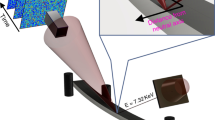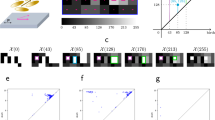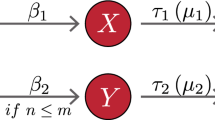Abstract
Many complex and disordered systems fail to reach equilibrium after they have been quenched or perturbed. Instead, they sluggishly relax toward equilibrium at an ever-slowing, history-dependent rate, a process termed physical aging. The microscopic processes underlying the dynamic slow-down during aging and the reason for its similar occurrence in different systems remain poorly understood. Here, we reveal the structural mechanism underlying logarithmic aging in disordered mechanical systems through experiments in crumpled sheets and simulations of a disordered network of bistable elastic elements. We show that under load, the system self-organizes to a metastable state poised on the verge of an instability, where it can remain for long, but finite, times. The system’s relaxation is intermittent, advancing via rapid sequences of instabilities, grouped into self-similar, aging avalanches. Crucially, the quiescent dwell times between avalanches grow in proportion to the system’s age, due to a slow increase of the lowest effective energy barrier, which leads to logarithmic aging.
This is a preview of subscription content, access via your institution
Access options
Access Nature and 54 other Nature Portfolio journals
Get Nature+, our best-value online-access subscription
$29.99 / 30 days
cancel any time
Subscribe to this journal
Receive 12 print issues and online access
$209.00 per year
only $17.42 per issue
Buy this article
- Purchase on Springer Link
- Instant access to full article PDF
Prices may be subject to local taxes which are calculated during checkout



Similar content being viewed by others
Data availability
All data needed to evaluate the conclusions are presented in the paper and/or the Supplementary Information. Experimental datasets are available in the Supplementary Information. Datasets generated during the current study are available from the corresponding author upon reasonable request.
Code availability
An example of the LAMMPS simulation script used in this study is available in the Supplementary Information. Other scripts and numerical data are available from the corresponding author upon reasonable request.
References
Matan, K., Williams, R. B., Witten, T. A. & Nagel, S. R. Crumpling a thin sheet. Phys. Rev. Lett. 88, 076101 (2002).
Lahini, Y., Gottesman, O., Amir, A. & Rubinstein, S. Nonmonotonic aging and memory retention in disordered mechanical systems. Phys. Rev. Lett. 118, 8 (2017).
Kramer, E. M. & Lobkovsky, A. E. Universal power law in the noise from a crumpled elastic sheet. Phys. Rev. E 53, 1465 (1996).
Shohat, D., Hexner, D. & Lahini, Y. Memory from coupled instabilities in unfolded crumpled sheets. Proc. Natl Acad. Sci. USA 119, e2200028119 (2022).
Houle, P. A. & Sethna, J. P. Acoustic emission from crumpling paper. Phys. Rev. E 54, 278 (1996).
Keim, N. C., Paulsen, J. D., Zeravcic, Z., Sastry, S. & Nagel, S. R. Memory formation in matter. Rev. Mod. Phys. 91, 035002 (2019).
Oppenheimer, N. & Witten, T. A. Shapeable sheet without plastic deformation. Phys. Rev. E 92, 052401 (2015).
Shohat, D. & Lahini, Y. Dissipation indicates memory formation in driven disordered systems. Phys. Rev. Lett. 130, 048202 (2023).
Lahini, Y., Rubinstein, S. M. & Amir, A. Crackling noise during slow relaxations in crumpled sheets. Phys. Rev. Lett. 130, 258201 (2023).
Barrat, J.-L., Feigelman, M., Kurchan, J. & Dalibard, J. (eds) Slow Relaxations and Nonequilibrium Dynamics in Condensed Matter: Les Houches Session LXXVII (Springer Berlin Heidelberg, 2003).
Gurevich, A. & Küpfer, H. Time scales of the flux creep in superconductors. Phys. Rev. B 48, 6477 (1993).
Vaknin, A., Ovadyahu, Z. & Pollak, M. Aging effects in an Anderson insulator. Phys. Rev. Lett. 84, 3402 (2000).
Grenet, T., Delahaye, J., Sabra, M. & Gay, F. Anomalous electric-field effect and glassy behaviour in granular aluminium thin films: electron glass?. Eur. Phys. J. B 56, 183–197 (2007).
Morgan, I. L., Avinery, R., Rahamim, G., Beck, R. & Saleh, O. A. Glassy dynamics and memory effects in an intrinsically disordered protein construct. Phys. Rev. Lett. 125, 058001 (2020).
Lieleg, O., Kayser, J., Brambilla, G., Cipelletti, L. & Bausch, A. R. Slow dynamics and internal stress relaxation in bundled cytoskeletal networks. Nat. Mater. 10, 236–242 (2011).
Kaplan, Y. et al. Observation of universal ageing dynamics in antibiotic persistence. Nature 600, 290–294 (2021).
Ben-David, O., Rubinstein, S. M. & Fineberg, J. Slip-stick and the evolution of frictional strength. Nature 463, 76–79 (2010).
Kaz, D. M., McGorty, R., Mani, M., Brenner, M. P. & Manoharan, V. N. Physical ageing of the contact line on colloidal particles at liquid interfaces. Nat. Mater. 11, 138–142 (2012).
Song, J. et al. Microscopic dynamics underlying the stress relaxation of arrested soft materials. Proc. Natl Acad. Sci. USA 119, e2201566119 (2022).
Knight, J. B., Fandrich, C. G., Lau, C. N., Jaeger, H. M. & Nagel, S. R. Density relaxation in a vibrated granular material. Phys. Rev. E 51, 3957 (1995).
Angell, C. A. Formation of glasses from liquids and biopolymers. Science 267, 1924–1935 (1995).
Debenedetti, P. G. & Stillinger, F. H. Supercooled liquids and the glass transition. Nature 410, 259–267 (2001).
Arceri, F., Landes, F. P., Berthier, L. & Biroli, G. A Statistical Mechanics Perspective on Glasses and Aging. In Encyclopedia of Complexity and Systems Science (ed. Meyers, R. A.) pp 1–68 (Springer Berlin Heidelberg, 2020).
Lundgren, L., Svedlindh, P., Nordblad, P. & Beckman, O. Dynamics of the relaxation-time spectrum in a CuMn spin-glass. Phys. Rev. Lett. 51, 911 (1983).
Struik, L. C. E. Physical aging in plastics and other glassy materials. Polym. Eng. Sci. 17, 165–173 (1977).
Qiao, J. & Pelletier, J.-M. Dynamic mechanical relaxation in bulk metallic glasses: a review. J. Mater. Sci. Technol. 30, 523–545 (2014).
Weeks, E. R., Crocker, J. C., Levitt, A. C., Schofield, A. & Weitz, D. A. Three-dimensional direct imaging of structural relaxation near the colloidal glass transition. Science 287, 627–631 (2000).
Samarakoon, A. et al. Aging, memory, and nonhierarchical energy landscape of spin jam. Proc. Natl Acad. Sci. USA 113, 11806–11810 (2016).
Narayanaswamy, O. A model of structural relaxation in glass. J. Am. Ceram. Soc. 54, 491–498 (1971).
Bouchaud, J.-P. Weak ergodicity breaking and aging in disordered systems. J. Phys. I 2, 1705–1713 (1992).
Cugliandolo, L. F. & Kurchan, J. Analytical solution of the off-equilibrium dynamics of a long-range spin-glass model. Phys. Rev. Lett. 71, 173 (1993).
Sibani, P. & Hoffmann, K. H. Hierarchical models for aging and relaxation of spin glasses. Phys. Rev. Lett. 63, 2853 (1989).
Sibani, P. & Littlewood, P. B. Slow dynamics from noise adaptation. Phys. Rev. Lett. 71, 1482 (1993).
Rinn, B., Maass, P. & Bouchaud, J.-P. Multiple scaling regimes in simple aging models. Phys. Rev. Lett. 84, 5403 (2000).
Kolvin, I. & Bouchbinder, E. Simple nonlinear equation for structural relaxation in glasses. Phys. Rev. E 86, 010501 (2012).
Amir, A., Oreg, Y. & Imry, Y. On relaxations and aging of various glasses. Proc. Natl Acad. Sci. USA 109, 1850–1855 (2012).
Robe, D. M., Boettcher, S., Sibani, P. & Yunker, P. Record dynamics: direct experimental evidence from jammed colloids. EPL 116, 38003 (2016).
Boettcher, S., Robe, D. M. & Sibani, P. Aging is a log-poisson process, not a renewal process. Phys. Rev. E 98, 020602 (2018).
Douglass, I. M. & Dyre, J. C. Distance-as-time in physical aging. Phys. Rev. E 106, 054615 (2022).
Kovacs, A. J., Aklonis, J. J., Hutchinson, J. M. & Ramos, A. R. Isobaric volume and enthalpy recovery of glasses. II. A transparent multiparameter theory. J. Polym. Sci. B: Polym. Phys. 17, 1097–1162 (1979).
Yan, L., Düring, G. & Wyart, M. Why glass elasticity affects the thermodynamics and fragility of supercooled liquids. Proc. Natl Acad. Sci. USA 110, 6307–6312 (2013).
Bak, P., Tang, C. & Wiesenfeld, K. Self-organized criticality. Phys. Rev. A 38, 364 (1988).
Witten, T. A. Stress focusing in elastic sheets. Rev. Mod. Phys. 79, 643 (2007).
Blair, D. L. & Kudrolli, A. Geometry of crumpled paper. Phys. Rev. Lett. 94, 166107 (2005).
Andrejevic, J., Lee, L. M., Rubinstein, S. M. & Rycroft, C. H. A model for the fragmentation kinetics of crumpled thin sheets. Nat. Commun. 12, 1–10 (2021).
Lechenault, F. & Adda-Bedia, M. Generic bistability in creased conical surfaces. Phys. Rev. Lett. 115, 235501 (2015).
Beggs, J. M. & Plenz, D. Neuronal avalanches in neocortical circuits. J. Neuro. 23, 11167–11177 (2003).
Thompson, A. P. et al. Lammps - a flexible simulation tool for particle-based materials modeling at the atomic, meso, and continuum scales. Comput. Phys. Commun. 271, 108171 (2022).
Widmer-Cooper, A., Harrowell, P. & Fynewever, H. How reproducible are dynamic heterogeneities in a supercooled liquid. Phys. Rev. Lett. 93, 135701 (2004).
Hänggi, P., Talkner, P. & Borkovec, M. Reaction-rate theory: fifty years after kramers. Rev. Mod. Phys. 62, 251 (1990).
Popovic, M., de Geus, T. W., Ji, W., Rosso, A. & Wyart, M. Scaling description of creep flow in amorphous solids. Phys. Rev. Lett. 129, 20 (2022).
Jaeger, H., Liu, C.-h & Nagel, S. R. Relaxation at the angle of repose. Phys. Rev. Lett. 62, 40 (1989).
Lubchenko, V. & Wolynes, P. G. Theory of structural glasses and supercooled liquids. Annu. Rev. Phys. Chem. 58, 235–266 (2007).
Ritort, F. & Sollich, P. Glassy dynamics of kinetically constrained models. Adv. Phys. 52, 219–342 (2003).
Chacko, R. N. et al. Elastoplasticity mediates dynamical heterogeneity below the mode coupling temperature. Phys. Rev. Lett. 127, 048002 (2021).
Kumar, D. et al. Mapping out the glassy landscape of a mesoscopic elastoplastic model. J. Chem. Phys. 157, 174504 (2022).
Ozawa, M. & Biroli, G. Elasticity, facilitation, and dynamic heterogeneity in glass-forming liquids. Phys. Rev. Lett. 130, 138201 (2023).
Tahaei, A., Biroli, G., Ozawa, M., Popović, M. & Wyart, M. Scaling description of dynamical heterogeneity and avalanches of relaxation in glass-forming liquids. Preprint at https://arxiv.org/abs/2305.00219 (2023).
Keta, Y.-E., Mandal, R., Sollich, P., Jack, R. L. & Berthier, L. Intermittent relaxation and avalanches in extremely persistent active matter. Soft Matter 19, 3871–3883 (2023).
Dyre, J. C. Colloquium: the glass transition and elastic models of glass-forming liquids. Rev. Mod. Phys. 78, 953 (2006).
Wales, D. J., Miller, M. A. & Walsh, T. R. Archetypal energy landscapes. Nature 394, 758–760 (1998).
Janke, W. & Janke, W. Rugged Free-Energy Landscapes–An Introduction (Springer, 2008).
Jules, T., Lechenault, F. & Adda-Bedia, M. Plasticity and aging of folded elastic sheets. Phys. Rev. E 102, 033005 (2020).
Nicolas, A., Ferrero, E. E., Martens, K. & Barrat, J.-L. Deformation and flow of amorphous solids: insights from elastoplastic models. Rev. Mod. Phys. 90, 045006 (2018).
Priesemann, V. et al. Spike avalanches in vivo suggest a driven, slightly subcritical brain state. Front. Syst. Neurosci. 8, 108 (2014).
Bauke, H. Parameter estimation for power-law distributions by maximum likelihood methods. Eur. Phys. J. B 58, 167–173 (2007).
Acknowledgements
We are grateful to D. Hexner, S. Reuveni, E. Bouchbinder, E. Lerner and K. González-Lopéz for insightful discussions and to Y. Shokef, H. Diamant and Y. Bar-Sinai for comments on the manuscript. We also thank B. Hirshberg for sharing insights on using LAMMPS and D. Hexner for providing the disordered network topologies. This work was supported by the Israel Science Foundation grants 2096/18 and 2117/22. D.S. acknowledges support from the Clore Israel Foundation.
Author information
Authors and Affiliations
Contributions
Y.F. and Y.L. designed and performed experiments. D.S. and Y.L. wrote the LAMMPS model, ran the simulations and analysed the experimental and numerical results. D.S., Y.F. and Y.L. wrote the manuscript.
Corresponding authors
Ethics declarations
Competing interests
The authors declare no competing interests.
Peer review
Peer review information
Nature Physics thanks Seung-Hun Lee, Kari Dalnoki-Veress and the other, anonymous, reviewer(s) for their contribution to the peer review of this work.
Additional information
Publisher’s note Springer Nature remains neutral with regard to jurisdictional claims in published maps and institutional affiliations.
Supplementary information
Supplementary Information
Supplementary Video 1, Figs. 1–11 and Sections 1–4.
Supplementary Video 1
In the supplementary video, we show the compaction of a network of n = 2,000 nodes under external forcing and weak thermal noise T = 10−3. While thermal fluctuations are barely apparent, they suffice to trigger large-scale avalanches of instabilities. The avalanches are separated by long quiescent waiting times in which the system is stationary, other than equilibrium-like fluctuations. These waiting timed grow longer as the systems ages. Bond colour in the video represents the potential energy of each bond U(δRij), as shown by the colourbar in Supplementary Fig. 1. Blue bonds are close to one of their minimal energy states, while red bonds are on the verge of instability. Note the distribution of unstable bonds in the network, the occurrence of avalanches separated by (growing) quiescent dwell times, and how avalanches generate new unstable bonds. This highlights the process by which the network self-organizes to a state on the verge of instability.
Supplementary Data 1
Processed experimental data of the acoustic emissions of crumpled sheets under external load. It also contained an example script for the LAMMPS simulations used in the study.
Rights and permissions
Springer Nature or its licensor (e.g. a society or other partner) holds exclusive rights to this article under a publishing agreement with the author(s) or other rightsholder(s); author self-archiving of the accepted manuscript version of this article is solely governed by the terms of such publishing agreement and applicable law.
About this article
Cite this article
Shohat, D., Friedman, Y. & Lahini, Y. Logarithmic aging via instability cascades in disordered systems. Nat. Phys. 19, 1890–1895 (2023). https://doi.org/10.1038/s41567-023-02220-2
Received:
Accepted:
Published:
Issue Date:
DOI: https://doi.org/10.1038/s41567-023-02220-2
This article is cited by
-
One crumple at a time
Nature Physics (2023)



